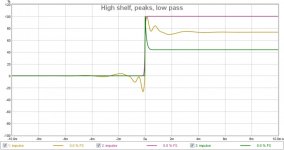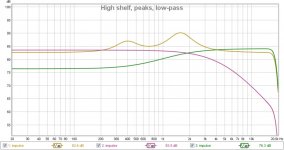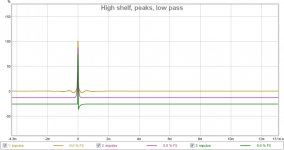This is excellent ! Much less than +- 200us throughout the whole frequency range, apart from the lower cutoff. But that would make unreasonably long FIR filters necessary with a lot of delay. And it looks as if speakers that show minimum phase behaviour at their lower cutoff seem to be perceived as more natural than those with linear phase behaviour.
Regards
Charles
Regards
Charles
This is excellent ! Much less than +- 200us throughout the whole frequency range, apart from the lower cutoff. But that would make unreasonably long FIR filters necessary with a lot of delay. And it looks as if speakers that show minimum phase behaviour at their lower cutoff seem to be perceived as more natural than those with linear phase behaviour.
Regards
Charles
I tried it both ways and prefer the lower cut-off following minimum phase behaviour. More natural sound and flow, more feet tapping 😉.
Microseconds - but yes, the Two Towers would be if anything is.
My bad...
Last edited:
...and at the same time denying the relevance of the time-response.
Maybe you didn't read the whole text. Joe is a normal person, not an individual
pretending to be uber mensch. He has priorities well defined, and the time
behavior isn't in the first place.
HOBBY HIFI: Then, for you, is the amplitude more important than the time behavior of a loudspeaker?
D'Appolito: I develop loudspeakers in the frequency range and look after what happens in the time domain. Clearly, the sound pressure amplitude is important to me. Everyone talks about timely loudspeakers. Of course - you can adjust the time at the cut-off frequency. However, different frequencies pass through a loudspeaker at different times, even within a chassis, runtime differences occur. You can not balance all these run-time differences
- a perfect time adjustment is illusory.
HOBBY HIFI: What is the most important thing to do a good loudspeaker development?
D 'Appolito: A good pair of ears and good engineering.
HOBBY HIFI: "We wish you all the best. Thank you very much for this interview and we wish you all the best for your work!"
If you want an opposing view, just look up John Dunlavy...
I was curious enough to try it and find my own opinion. And no, I'd not rate time behaviour above frequency response, but why should one have to choose between them.
And no, it's not just about straightening the phase with FIR filters down to DC.
That would have taken me half an hour, not half a year to get it right.
I was curious enough to try it and find my own opinion. And no, I'd not rate time behaviour above frequency response, but why should one have to choose between them.
And no, it's not just about straightening the phase with FIR filters down to DC.
That would have taken me half an hour, not half a year to get it right.
Something important is still lacking IMHO: A proper definition or standard of the maximally allowed group-delay distortion vs frequency. The Blauert and Laws findings are interesting but not sufficient IMO.
Soemone from the German "Institut für Rundfunktechnik" (IRT) once found the the group delay distortion shouldn't be greater than +- 200us in the midrange. I don't know whether this is sufficient but it does definitely give some leeway to the x-over designers when it comes to using x-overs of orders greater than one (but would still prohibit LR4 in some cases).
There is some recent information about the maximally allowed group-delay distortion vs frequency under title "Critères de Fleischer et Zwicky" in the middle of this page filtre "quasi-optimal" : modèles et variantes - Le blog de jimbee ,
Below are two images from this blog written by DiyAudio member Jmbee.


Member
Joined 2009
Paid Member
D'Appolito: ...The depth offset has an optimum effect only on the axis. If you look at the loudspeaker sideways, that is to say under 90 degrees, then there is no depth offset. A depth offset on the baffle is therefore unsuitable for achieving the optimum round beam behavior required by me.
whoa, I love it when another light bulb goes on. I had been thinking about designs with a set-back tweeter for time alignment and it had simply not occurred to me that this is accurate only on-axis. I've only ever built single full range speakers but of late started the process of reading about multi-ways to learn more about them. They are more complex than I had expected.
Originally Posted by Lojzek View Post
D'Appolito: ...The depth offset has an optimum effect only on the axis. If you look at the loudspeaker sideways, that is to say under 90 degrees, then there is no depth offset. A depth offset on the baffle is therefore unsuitable for achieving the optimum round beam behavior required by me.
Ahh... but not so when one talks about a time aligned single point horn like Bwaslo's Cosyne.
Ahh... but not so when one talks about a time aligned single point horn like Bwaslo's Cosyne.
Or tamed line arrays...
So, digital delay with a flat baffle?whoa, I love it when another light bulb goes on. I had been thinking about designs with a set-back tweeter for time alignment and it had simply not occurred to me that this is accurate only on-axis.
I wish DSP had matured a little earlier so we could see what Dunlavy did with it. His 1996 Stereophile interview talks a bit about a digital prototype.
Not having a crossover certainly helps.Or tamed line arrays...
I've only ever built single full range speakers but of late started the process of reading about multi-ways to learn more about them. They are more complex than I had expected.
In reality, a multiway system isn't as hard to build as world would like us to
believe. You just have to pay attention to what really matters and Dr. D'Appolito
explicitly mentioned what that is, the first wave front frequency response.
Nothing wrong with setting back the tweeter. In that respect you won't have
to compensate by adding a higher order filter, for you already did it mechanically.
X, can you post the vertical polar response of your 10F/RS225 speaker? I am interested in seeing what happens off-axis with your crossover choices.
From my listening experience, it is pretty clear that on-axis response is absolutely the primary objective. If you don't get that right, the tonal balance suffers and then no amount of flat phase is going to sound good. Second, the power response further amplifies the tonal balance via reflected sound in the room. Get these two things right and you are mostly there. Now, we can start talking about things like phase response.
Those apparently "poor" step responses are not bad at all. All they indicate is that the crossovers are properly done. They do not determine whether the speaker will sound good or bad. A triangular step response does not in any way tell you how a speaker will sound, and it should not be held up as proof of good sound.
BTW, how did we get into this topic? Isn't this thread about the SF Amati?
From my listening experience, it is pretty clear that on-axis response is absolutely the primary objective. If you don't get that right, the tonal balance suffers and then no amount of flat phase is going to sound good. Second, the power response further amplifies the tonal balance via reflected sound in the room. Get these two things right and you are mostly there. Now, we can start talking about things like phase response.
Those apparently "poor" step responses are not bad at all. All they indicate is that the crossovers are properly done. They do not determine whether the speaker will sound good or bad. A triangular step response does not in any way tell you how a speaker will sound, and it should not be held up as proof of good sound.
BTW, how did we get into this topic? Isn't this thread about the SF Amati?
Last edited:
Member
Joined 2009
Paid Member
what is this based on, why wouldn't it tell you something about the sound ?A triangular step response does not in any way tell you how a speaker will sound, and it should not be held up as proof of good sound.
BTW, how did we get into this topic? Isn't this thread about the SF Amati?
well the original post contained almost no information so of course we wandered off 😛
maybe this is of interest: one of the most impressive DIY speaker projects I've ever seen !
http://www.diyaudio.com/forums/multi-way/169623-sonus-faber-amati-diy.html
The reason is pretty simple, Bigun. The step response does not tell us what the frequency response looks like. I hatched this up in rephase quickly. Three supposedly triangular step responses and three frequency responses to go with them. Would you say any of these three speakers sounds good?
Attachments
I think we all agree even or balanced frequency response is first thing our ears hear. Given two speakers with flat frequency response, the one with a clean impulse and nice triangle step will sound more realistic when listening to naturally mic'd and minimally post processed percussion. Like small jazz ensembles, drums, guitar, piano, castanets, marimba, bells, etc.
Bigun,
Thanks for the link:
http://www.diyaudio.com/forums/multi-way/169623-sonus-faber-amati-diy.html
Certainly impressive DIY effort. I wonder what the impulse and step looks like?
Bigun,
Thanks for the link:
http://www.diyaudio.com/forums/multi-way/169623-sonus-faber-amati-diy.html
Certainly impressive DIY effort. I wonder what the impulse and step looks like?
Last edited:
Member
Joined 2009
Paid Member
The reason is pretty simple, Bigun. The step response does not tell us what the frequency response looks like. I hatched this up in rephase quickly. Three supposedly triangular step responses and three frequency responses to go with them. Would you say any of these three speakers sounds good?
got it, see what you mean !
I think we all agree even or balanced frequency response is first thing our ears hear. Given two speakers with flat frequency response, the one with a clean impulse and nice triangle step will sound more realistic when listening to naturally mic'd and minimally post processed percussion. Like small jazz ensembles, drums, guitar, piano, castanets, marimba, bells, etc.
Ok, so, we can agree that the step response by itself is no proof of good sound. You agree that frequency response is the "first thing" our ears hear. But is it the only thing our ears hear (up to reasonable limits)? We can hear gross timing errors. If they are very long, we call them echoes. If the phase causes ripples in the FR, yes, we will hear it. But two identical FRs, and different phase within reason, I doubt you'll be able to hear it. Maybe on gun shots and ricochets, but on normal music? Unlikely. I am going to run some tests and put a poll out.
I wonder what the impulse and step looks like?
Here are the three impulse responses to go with the SPL and step responses posted earlier. Pretty clean impulses, huh? Look at the SPL response. Probably not speakers you want to hear for any length of time.
Attachments
Last edited:
The very first few Sonus Faber speakers were extremely impressive, but today's are nothing special to me. i heard they are also manufacutred in China these days...
We can hear gross timing errors. If they are very long, we call them echoes. If the phase causes ripples in the FR, yes, we will hear it. But two identical FRs, and different phase within reason, I doubt you'll be able to hear it. Maybe on gun shots and ricochets, but on normal music? Unlikely. I am going to run some tests and put a poll out.
I do hope you have plans for something other than another headphone test. We use more than our ears alone to judge sound.
- Status
- Not open for further replies.
- Home
- Loudspeakers
- Multi-Way
- Short review of the newest Sonus Faber Amati


